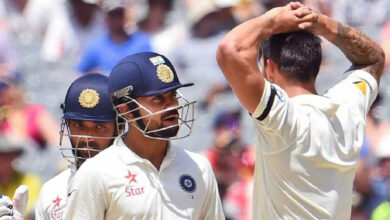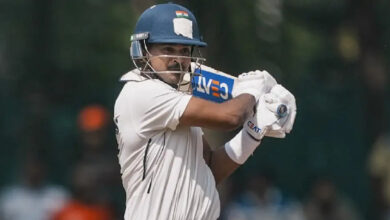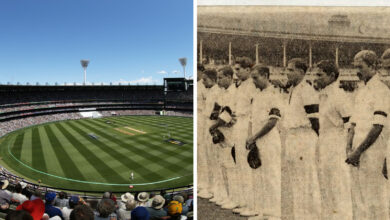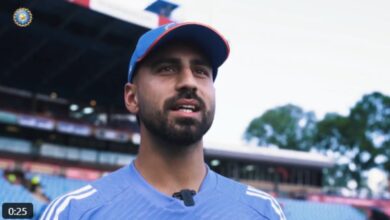In the danger zone of the drag-flick: Tirkey, Rasquinha recall fractures, close calls, Pakan’s Sohail Abbas’s speed

Dilip Tirkey is scarred for life. Literally.
Eighteen years ago, in October 2004 at Delhi’s National Stadium, Tirkey was manning the right goalpost when Pakan legend Sohail Abbas unleashed his trademark ferocious drag-flick. On the left post was Viren Rasquinha. And they both watched in dread as goalkeeper Adrian D’Souza, in his inimitable style, charged out to block Abbas’ shot.
For Rasquinha and Tirkey, D’Souza’s runs made the sighting the ball that much tougher. “If he wouldn’t be able to stop the ball, it would come through his legs or under his arms. And Sohail had a sling action, so you couldn’t judge where the ball was going,” Rasquinha says.
“In that match against Pakan, we had planned that Dilip would take the right post down and I’d take the left. Sohail flicked, Adrian rushed out, the ball it deflected slightly off him and deviated from its path.”
Tirkey, not a man of many words, gets in the flow while narrating what happened next. “I wasn’t able to spot the ball. When Adrian rushed out, I just turned a little and before I could even react further, the ball hit my eye. Ekdum sunn hogaya thode second k liye and phir, gir gaya (I went numb for a few seconds and then, fell to the ground). I couldn’t open my right eye.”
Tirkey suffered a hairline fracture just under his right eye. He says he is trembling even now, while recalling the incident that took place nearly two decades ago. “The mark is still there and it pains even today, especially during winters,” he says.
The potential danger of the hockey ball flying at high speeds following a drag-flick and the future of the penalty corner, an integral part of the sport, is up for discussion and review after the International Hockey Federation launched a consultation project titled: ‘Future of the Penalty Corner’.
The danger during drag-flicks is more pronounced for defenders, especially the first rushers, the player who runs towards the flicker to cut his angle, and the postmen, those guarding the posts, like Rasquinha and Tirkey.
When the two of them played, the defenders did not wear a lot of protective gear. Like Gavaskar facing the fearsome West Indian pacers with nothing else but only a floppy hat, the defenders back then depended largely on their reflexes, and a little luck.
“I won’t lie, we used to be very scared. Ball zoo-zoo karke jaata hai,” Tirkey says. Rasquinha, who shared that fear, adds: “We stood without any protection at all, except the abdomen guard. Most of us didn’t even wear gum guards so my colossal fear was that the ball would hit me bang on my teeth and I’d lose all of them. If was a genuine fear.”
Over the years, the rules have changed and defenders are given 40 seconds to wear all their protective gear – face masks, gloves, knee pads, and such. It has reduced the severity of injuries in some cases and proponents of drag flicks say the advancements in technology should be used to make penalty corners safer, rather than changing the rules.
“For me, it’s like F1 racing,” says Gonzalo Peillat, whose drag flicks launched Argentina to the top of the podium in the Rio Olympics. Peillat, who now represents Germany in international hockey and is one of the finest contemporary drag-flickers, isn’t pleased with FIH’s move, saying that penalty corners are no less dangerous compared to other situations from open play.
“I don’t think it’s (the PC review) a good idea. In F1, there are less and less injuries because of the technology. We can have the same even in hockey. We use a lot of equipment that protects everything, from the face to the foot. In the last two Olympics, there wasn’t even one injury through penalty corners,” Peillat says.
That doesn’t necessarily mean they are completely safe.
At the Tokyo Olympics, India defender Amit Rohidas, considered to be one of the finest first rushers in the country, suffered bruises on his chest, abdomen, knee and ankle in just one match – against Germany in the bronze medal playoff. What Rohidas does is dubbed in hockey as ‘suicide running’ – charging directly towards the flicker, to stop the shot even if it means suffering a blow.
The FIH has argued that the protective gear has given the defenders a false sense of security, which leads to them running straight into the path of the ball without thinking of the consequences. Rasquinha agrees. “The speed at which the ball travels, no face mask will protect you if you get hit directly,” he says.
Rasquinha’s mind harks back to the early winter encounter against Pakan in 2004. After the match in Delhi, where Tirkey got injured, the caravan moved to Chandigarh and from there, to Amritsar where Abbas scored his world record 268th goal.
Rasquinha remembers the goal not just for the record, but also because it nearly took his head off. “I was guarding the left goal post. And again, Adrian charged out. This time, the ball came from under his armpit. I could not see it until the last second when I noticed that it was headed straight for the middle of my eyes. I just ducked at the last split second and as the ball went over my head, I could feel the breeze…” he says.
The shot was so fast, the former India captain adds, that the ball tore through the net and hit the advertisement boards. “The referee thought it went over the goal and signalled out. But all the Pakani players and I knew it went into the goal.” Rasquinha pauses momentarily to reflect. Then adds: “I had no face mask, no gum guard… I could have died that day.”







